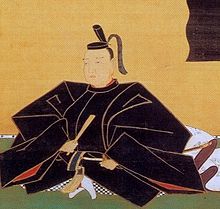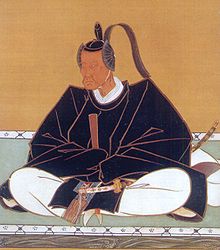Hosokawa clan
 The spacious Japanese garden of Suizenji Jojuen, in Kumamoto City | |
| Pronunciation | Hosokawa |
|---|---|
| Origin | |
| Word/name | Japanese |
| Region of origin | Japanese |
| Other names | |
| Related names | Nagaoka |
The Hosokawa clan (細川氏, Hosokawa-shi) was a Japanese samurai clan, descended from Emperor Seiwa (850-880) and a branch of the Minamoto clan, by the Ashikaga clan. It produced many prominent officials in the Ashikaga shogunate's administration. In the Edo period, the Hosokawa clan was one of the largest landholding daimyo families in Japan. In the present day, Morihiro Hosokawa, one of its descendants, has achieved notoriety through his tenure as Prime Minister of Japan.
Muromachi and Sengoku eras
Ashikaga Yoshisue, son of Ashikaga Yoshizane, was the first to take the name of Hosokawa. Hosokawa Yoriharu, a Hosokawa of the late Kamakura period, fought for the Ashikaga clan against the Kamakura shogunate. Another, Hosokawa Akiuji, helped establish the Ashikaga shogunate.
The clan wielded significant power over the course of the Muromachi (1336-1467), Sengoku (1467-1600), and Edo periods, moving, however, from Shikoku, to Kinai, and then to Kyūshū over the centuries.
The clan was also one of three families to dominate the post of Kanrei (Shogun's deputy), under the Ashikaga shogunate. One such individual was Hosokawa Yoriyuki. At the beginning of the Ashikaga's rule, the Hosokawa were given control of the entirety of Shikoku. Over the course of this period, members of the Hosokawa clan were Constables (shugo) of Awa, Awaji, Bitchu, Izumi, Sanuki, Settsu, Tamba, Tosa, and Yamashiro Provinces.

A conflict between Hosokawa Katsumoto, the fifth Kanrei, and his father-in-law Yamana Sōzen, over the shogunate's succession, sparked the Ōnin War, which led to the fall of the shogunate and a period of 150 years of chaos and war, known as Sengoku. Following the fall of the Ashikaga shogunate, which was based in Kyoto, control of the city, and thus obstensibly the country, fell into the hands of the Hosokawa clan (who held the post of Kyoto Kanrei - Shogun's deputy in Kyoto) for a few generations.
Katsumoto's son, Hosokawa Masamoto, held power in this way at the end of the 15th century, but was assassinated in 1507. After his death, the clan became divided and was weakened by internecine fighting. What power they still had, however, was centered in and around Kyoto. This gave them the leverage to consolidate their power to some extent, and came to be strong rivals with the Ōuchi family, both politically, and in terms of dominating trade with China. The Hosokawa remained in Kyoto for roughly one hundred years, fleeing the city when it was attacked by Oda Nobunaga.
Edo era

The Hosokawa of Kokura (later Kumamoto) became the "main" line of the Hosokawa clan during the Edo period. Hosokawa Gracia, the wife of Hosokawa Tadaoki, was one of the most famous samurai converts to Christianity; she was also the daughter of Akechi Mitsuhide.
The Hosokawa sided with Ishida Mitsunari during the decisive Sekigahara Campaign, and thus were made tozama (outsider) daimyo under the Tokugawa shogunate. They were given Higo province, with an income of 540,000 koku, as their han (fief).
Hosokawa Tadatoshi, the third lord of Kumamoto, was the patron of the swordsman Miyamoto Musashi.[1]
Though the Hosokawa domain was far from the capital, on Kyūshū, they were among the wealthiest of the daimyo. By 1750, Higo was one of the top producers of rice, and was in fact counted as a standard by the Osaka rice brokers. The domain suffered from serious economic decline after that, as most domains did, but Hosokawa Shigekata instituted a number of reforms which turned the situation around. He also founded a school, Seisei-kō, in 1755.[2]
There were four major branches of the Hosokawa clan in the Edo period, each of which held the title of daimyo. Another two branches of the family, under the Nagaoka surname, served the Hosokawa of Kumamoto as karō.
Boshin war
During the Boshin War of 1868-69, the Hosokawa of Kumamoto, Kumamoto-Shinden, and Udo sided with the imperial government. Its forces took part in the Battle of Aizu and the Battle of Hakodate, among others.
Meiji and beyond
The Hosokawa clan and its branches were made part of the new nobility in the Meiji era. In the present day, Morihiro Hosokawa, former Prime Minister of Japan, is a descendant of the Hosokawa of Kumamoto.
Key Genealogies
Kumamoto[3]
|
|
|
|
|
|
Kumamoto-Shinden (Takase)[4]
|
|
|
Udo[5]
|
|
|
|
Hitachi-Yatabe[6]
|
|
|
|
Notes
- ^ Wilson, The Lone Samurai, pp. 104-105.
- ^ Motoyama, Proliferating Talent, pp. 288-289.
- ^ "Hosokawa-shi (Higo Kumamoto hanshu-ke)" (ret. 27 Sept. 2008)
- ^ "Hosokawa-shi (Higo Kumamoto-shinden hanshu-ke)" (ret. 27 Sept. 2008)
- ^ "Hosokawa-shi (Higo Udo hanshu-ke)" (ret. 27 Sept. 2008)
- ^ "Hosokawa-shi (Yatabe hanshu-ke)" (ret. 27 Sept. 2008)
References
Japanese
English
- Frederic, Louis (2002). Japan Encyclopedia. Cambridge, Massachusetts: Harvard University Press.
- Motoyama, Yukihiko (1997). Proliferating Talent. Honolulu: University of Hawai'i Press.
- Sansom, George (1961). A History of Japan: 1334-1615. Stanford, California: Stanford University Press.
- Sansom, George (1963). A History of Japan: 1615-1867. Stanford, California: Stanford University Press.
- Wilson, William S. (2004). The Lone Samurai: The Life of Miyamoto Musashi. New York: Kodansha International.
